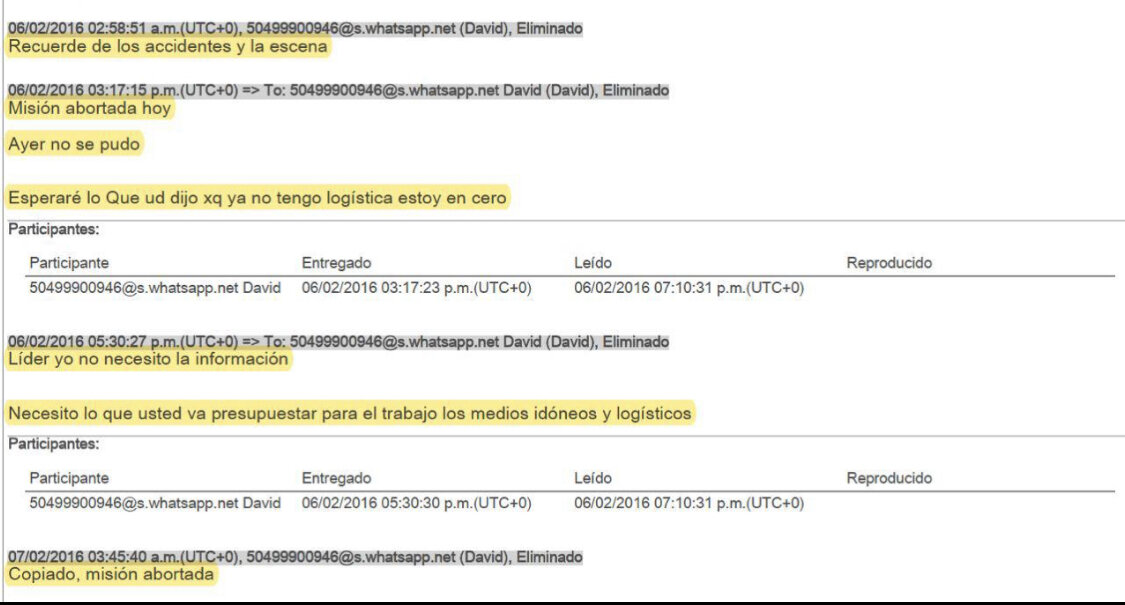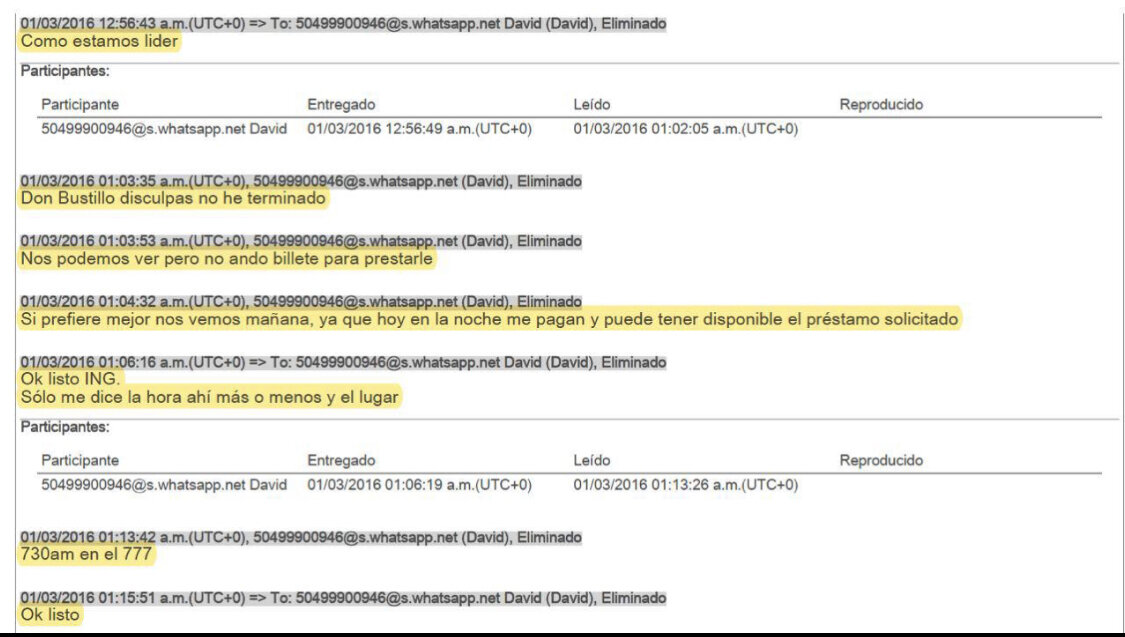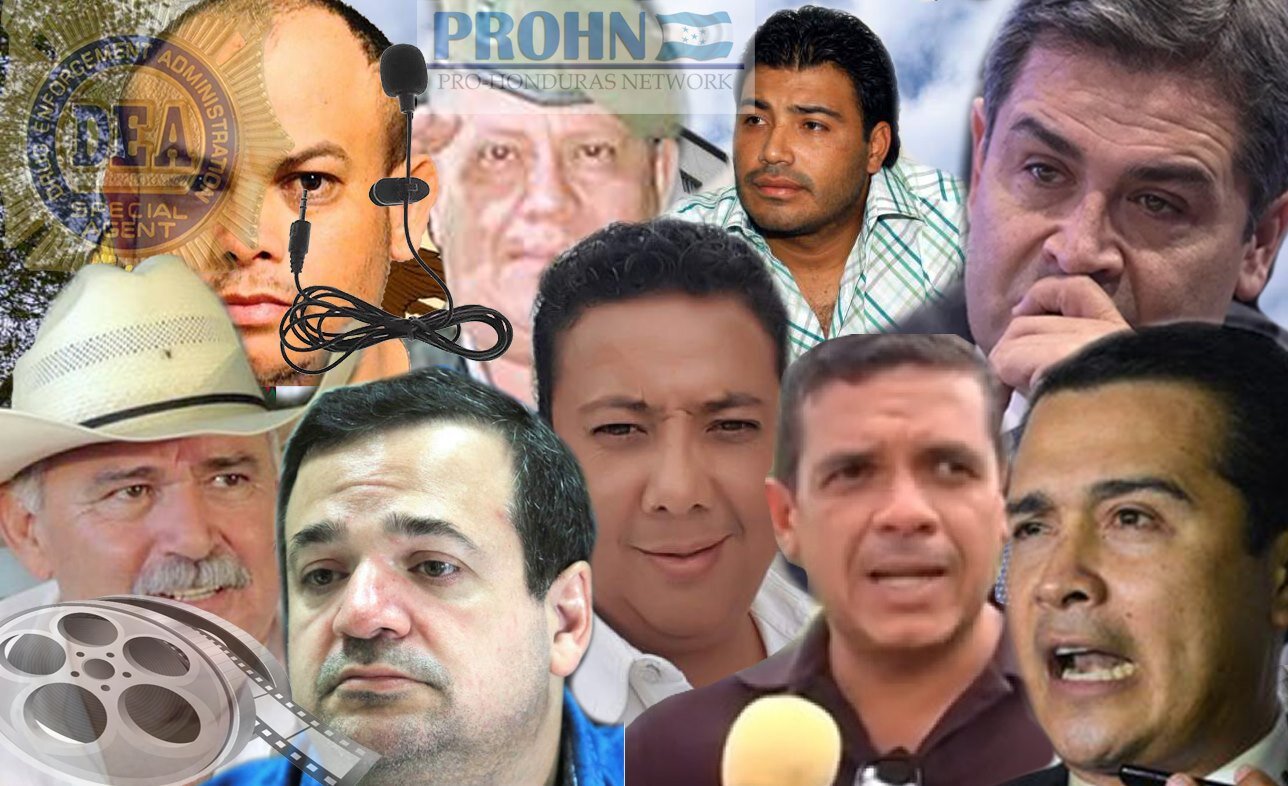DAY TWO: Trial Against David Castillo, Co-Author of Berta Cáceres's Murder
/Main Points of the Day
The lawyers (acusador privado) representing Berta Cáceres’s family present additional evidence including documents outlining a bank transfer for over $1,254,000 USD authorized by DESA’s Chief Financial Officer, Daniel Atala to Pemsa, the company directed by David Castillo (see pictures published by COPINH below). The date of the bank transfer is February 29, 2016 and the money is suspected to be direct evidence of payments made and authorized by DESA executives to Castillo, who then gave money to now-convicted murderer, Douglas Bustillo, while discussing plans to carry out some sort of action around the date of the bank transfer and just days before Berta Cáceres was murdered.
The defense asked the judges to recuse themselves from the case. The court ruled that the trial will be suspended until the Appeals Court rules on the defense’s motion. [NOTE: This is the fourth time that the defense has attempted to recuse the judges. Lawyer Victor Fernandez predicts that the Appeals court will rule within the next few days and if denied, the trial could continue next week]
To accompany the above images published by COPINH, COPINH writes: “Lawyers for Berta Cáceres’s family present proof about the payments made by Daniel Atala to David Castillo that coincide with conversations to coordinate the logistics of the criminal structure [that murdered Berta Cáceres].”
To announce this recently revealed evidence, COPINH and the legal team held a press conference outside of the court.
More Details:
General Contextual Information
Today, the Jitsi platform was used to broadcast the trial over Facebook instead of through a cell phone with poor audio and video quality. However, the audio was just as difficult to hear.
At the starting of today’s proceedings, Castillo’s defense attorneys complained again, like in previous hearings, about the camera angle of the live broadcast. In previous occasions, the defense argued that this puts them at risk and asked to have the angle moved. Today, the camera was moved to focus on the backs of the prosecutors and facing the ‘private accusers’ (acusadores privados) representing the Cáceres family.
Upon being denied entry into the courtroom yesterday, Laura Zúniga presented a letter to the court regarding her ability as a victim, to be physically present in the courtroom throughout the trial.
Prosecutors Present and Clarify Additional Evidence
The defense clarified details about evidence that will be used in the trial as well as presents additional forms of evidence. This includes:
Notifying the court of an error of the names of two technical consultants (consultores técnicos) that will ratify a legal document pertaining to the removal or collection of evidence (acta de levantamiento)
Presented physical evidence involving two cell phones (one black and one blue) that were seized from David Castillo. The cell phones are referred to in a document presented as evidence and part of an expert witness analysis.
Proposed a document outlining the data extraction of an LG phone that contained a voice message sent on March 31, 2016. The LG phone was obtained on April 30 ,2016. This piece of evidence is important in establishing the line of investigation carried out by Honduran investigators but was then discontinued because the information was manipulated. The document will be ratified by an expert witness. This document is part of an investigation carried out by the Office of the Special Prosecutor for the Prosecution of Officials of the Justice System and an indictment presented against police investigators. A copy of the acceptance of the expert witness, Emerson Moises Andino, who will analyze the cell phone was also presented.
Presents a technical consultant, Jose Eduardo Sierra, who will provide a technical analysis of an electronic data extraction in response to an analysis or expert witness testimony by Jonathan Murillo Maradiaga, who was presented by the defense.
Requests the court to formally cite two witnesses to testify - protected witness AAA who the prosecutors have been unable to locate, and Lilian Esperanza.
Presents Oscar Rodriguez, a technical consultant who will conduct an analysis of the expert witness testimony to be presented by Antonio Matamoros Cruz who was presented to testify by the defense to analyze data extracted from the LG phone.
Private Accusers Present and Clarify Additional Evidence
The private accusers (lawyers representing the Cáceres family) do not object to the evidence clarified or presented by the prosecutors.
Lawyers representing Salvador Zúniga (Berta Cáceres’s son):
Object to an expert witness Rubén Chapa presented by the defense arguing that the correct procedure was not followed. The defense alleged that the expert witness was threatened without providing proof and therefore, presented a document completed by the witness but without following the correct procedure.
Present an expert report written by expert Gladys Tzul called: ‘An Analysis of the situation and Condition of Violence Faced by Indigenous Women …” The private accusers argue that the expert testimony is relevant because it provides a scientific perspective about the motive of Berta Cáceres’s assassination and to outline the link between her status of being a woman and the planning and execution of her murder. The report also addresses the type of relationship between Castillo and Berta which is relevant considering that both are the main subjects of the trial and that the defense is attempting to argue that Castillo could not have committed the murder because he had a friendship with Berta.
The court clarified whether the expert had been sworn in. She has been sworn in and her report was submitted digitally to the court.
Lawyers representing Berta and Laura Zúniga and Austra Berta Flores:
Present a document dated February 6, 2019 that establishes the legal role of David Castillo in private company Pemsa (Potencia y Energía de Mesoamerica, S.A.). The relevance of this document is outlined in the second piece of evidence outlined below.
[NOTE: Pemsa is a Panama-registered company that is one of the two major shareholders of DESA. Castillo is the President of Pemsa and also of DESA. The other major shareholder of DESA is the company Inversiones Las Jacarandas, owned by the Atala Zablah family.]
Presents documents including evidence of a bank transfer requested by Daniel Atala, DESA’s Chief Financial Officer, to PEMSA on February 29, 2016 for approximately $1,254,000 USD. The documents also included another document dated September 11, 2012, that outlines the legal authorities granted to David Castillo including the ability to request loans, sign contracts, make deposits, etc. as Director of Pemsa. This evidence is relevant because it links to and connects with:
Chat messages and conversations extracted as evidence, between Douglas Bustillo and David Castillo that were discussing a plan to murder Berta Cáceres. Castillo refers to his ability to provide loans to Bustillo in a meeting held in person in Tegucigalpa. These conversations occurred on or around the date of the bank transfer to Pemsa. Castillo confirmed the transaction of money when speaking to Bustillo and Castillo later gave money to Bustillo at least one day before Berta was murdered [NOTE: Douglas Bustillo worked as head of DESA’s security. He was convicted in December 2018 for Berta Cáceres’s murder]
The bank transfer was requested by Daniel Atala who used a DESA institutional email (datala@desa.hn) to confirm the transaction.
Presents an expert report written by expert witness Harald Waxenecker titled: “Analysis of Roberto David Castillo Mejía’s position of corporate-institutional power and his involvement with the planning, coordination, and execution of Berta Cáceres’s murder". The expert specializes in understanding networks of corporate corruption and show that Castillo’s institutional power obtained through his positions inside the National Electrical Energy Company (ENEE) and the Armed Forces, to harass Berta Cáceres.
Waxenecker had already been accepted and sworn in by the court.
Requests the court to confirm whether Daniel Atala, who had been proposed by the private accusers and accepted by the court to testify, had been cited to appear. The court secretary confirms that Daniel Atala was notified on March 24, 2021 and that Atala’s private attorney confirmed that he would be testifying.
Presents the expert reports written by expert witness Andrés Arrieta, who will analyze telecommunications and the organizational structure that led to Berta’s murder.
Defense Asks Judges to Recuse Themselves (Again)
Arguing that the court has previously heard the evidence presented in this trial (referring to the case heard by the same court that led to the conviction of the seven individuals for Berta’s murder) and that the judges have a personal issue against the defense and it’s request made yesterday, the defense presented a request for the judges to recuse themselves from the case. [NOTE: This will be the fourth time that the defense has made such request and the fourth time that the same request will be sent to the Appeals Court].
Response of the Prosecutors to Defense’s Request
Argue that the defense is trying to provoke the prosecutors and the judges by making accusations against their professionalism and morals - provocations that have not resulted in either falling into their trap. Reminds the court that the same requests have been made previously and were denied by the Appeals court. Mentions that they are grateful that the hearing is being publicly broadcasted so that everyone could witness what is occurring in the trial. Argues that the defense is using irregular tactics to “painfully delay” the legal process. Reminds the court that the defense can be fined for these tactics and that the prosecutors have nothing personal against Castillo.
Response of the Private Accusers to Defense’s Request:
Argues that this is a delay tactic. The courts have already responded to such requests.
The judges leave to deliberate. Within an hour, the resolution is given.
Court Resolution to the Defense’s Recusal Request
The request will be sent to the Appeals court and the trial will be suspended until the Appeals court rules
[NOTE: Victor Fernandez, one of the lawyers representing Berta and Laura Zúniga and Berta’s mother, Berta Austra Flores, stated in a press conference held by COPINH outside the court that the Appeals court could respond within dates and that it’s possible that the trial will continue next week.]







